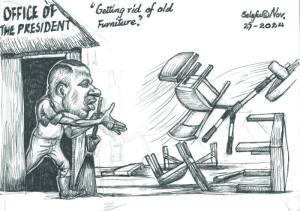The apparent tensions in the talks between government and De Beers are not only not new, but to an extent, common in any long-standing partnership built around sharing value. Staff Writer, MBONGENI MGUNI, recalls a much more difficult period in the 54-year ‘marriage’
When launching Belgian diamond firm, HB Antwerp on Monday, President Mokgweetsi Masisi detoured from his prepared remarks, just as he was beginning to make them.
“David Magang is a special guest of HB and mine. In all fairness, this is you and you started this.
“We have a lot of gratitude to you for your steadfastness that ‘one day, it will be.’”
The reference to Magang was not lost to many in the audience at the Innovation Hub, as the prominent lawyer, business tycoon and former Cabinet minister is well known for his spirited campaign to see diamond beneficiation activities take root in the country.
Since 2018, government and De Beers have been negotiating a new agreement governing sales from Debswana, the 50/50 joint venture the two partners established in 1969 which has grown to become the world’s largest rough diamond producer by value. Recently, it was revealed that the talks also include renewal of the mining leases for Jwaneng, Orapa, Damtshaa and Letlhakane which all expire in 2029.
While the talks and their eventual terms are a closely guarded secret, tensions in the negotiations recently boiled over into the public space when Masisi made remarks widely interpreted as a being desire for a greater revenue share from the 54-year old partnership with De Beers.
“This is the first time we are doing this and we are facing a giant of a company,” Masisi said at a ruling party rally in February.
“It’s the first time it has been shaken like this.
“These are our diamonds and we want a larger share for us, but through negotiations.”
This week government announced that it had snapped up 24% equity in HB Antwerp and allocated the Belgian company an as yet unquantified right to purchase diamonds from the Okavango Diamond Company (ODC), the state owned diamond trader.
HB Antwerp is a three-year old firm that specialises in applying high technology such as robotics to processing diamonds all through the value chain. Its founders boast that a two year arrangement with Lucara, in which stones from Karowe were bought at their estimated polished value rather than rough value, resulted in 40% higher royalties to government.
Government’s equity uptake in HB Antwerp has been read as a signal of broadly what the State is pushing for in its talks with De Beers, amidst reports that a greater allocation of Debswana’s production to ODC is amongst two remaining sticking points in the long drawn-out talks.
Government and De Beers have set themselves a deadline of June 30 to finalise their talks. Masisi’s reference to Magang however recalled an even more difficult period in the public-private partnership.
Writing in his 2015 masterpiece entitled “Delusions of Grandeur, Paradoxes and Ambivalences in Botswana’s Macroeconomic Firmament,” Magang provides details on the resistance Botswana met in the mid-2000s when it attempted to secure greater in-country value addition for itself from De Beers.
“The De Beers’ mining licence was coming up for renewal and putting his foot down, President Festus Mogae told Nicky Oppenheimer that unless De Beers took radical steps to facilitate the take-off of a diamond beneficiation revolution, he would pull the plug on their operations in the country and bring on board its competitors.
“Suddenly, the decades-old marriage was in danger of breaking down irretrievably.
“Mogae’s move was a bolt out of the blue,” wrote Magang.
At the time, De Beers argued that beneficiation in Botswana was simply not feasible as operating costs would wipe out any earnings. De Beers’ officials would point to the three diamond cutting and polishing firms operating in Botswana at the time and argue that these were failing, a position Magang wrote was disingenuous.
“It was De Beers, yes, that was the architect of their rather dismal operating results to buttress its oft-repeated and deluding argument that beneficiation was not tenable in this country,” Magang wrote.
Separately, Mmegi has learnt that from early in De Beers’ relationship with government, there had been an agreement that the terms of the original deal would change after De Beers recouped its initial capital investment. De Beers had initially expected to recoup its investment after seven years, but did so after only 18 months.
By the mid-2000s, the time was ripe for change and In May 2006, a landmark deal was struck.
The deal, known officially as a sales agreement, entailed plans to relocate De Beers’ Diamond Trading Centre to Botswana and also bring the sorting and aggregation of rough diamonds from London to Gaborone. Global diamond and polishing firms, who previously were contracted in exclusive purchase agreements with the Diamond Trading Centre in London, created local subsidiaries that government licensed to operate in Botswana and buy diamonds from the relocation of De Beers’ trading platforms to Botswana.
At the time of his final State of the Nation Address in November 2007, Mogae proudly reported that 16 diamond cutting and polishing companies had been granted licences, six of which were already operational and employing about 2,000 people.
On Monday, Masisi reported that the country had 48 cutting and polishing companies, employing 4,001 workers, nearly double the companies and double the jobs as during 2020. The success over the years is spurring Masisi and his negotiators to shake De Beers harder for greater value.
“The fact is that our country is blessed with diamonds, and it’s only logical that we should build our capabilities across the entire supply chain, so that we can lead in their transformation from rough stones to polished gems, and, finally, to fine jewellery and ornaments, that deliver the exquisite experience of luxury for the consumers,” the President said on Monday.








